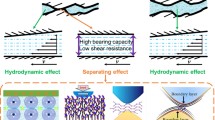Abstract
The growth concentration of cholesteric liquid crystals (CLCs) in lubricating materials was found to reduce the time needed to achieve the optimal tribological characteristics. It was also noted that, in the presence of small amounts of CLC in the lubricating material, the initial microrelief of the friction surfaces transformed into the flat-topped one during friction. A mechanism of CLC lubricity is proposed based on established regularities, according to which the gradual wear dosed by the friction-induced adsorption of CLC molecules in the lubricating material leads to the appearance of a flat-topped submicrotopography on the friction surfaces. This provides the conditions for the continuous formation of a lubricating film made from CLC molecules that screens the conjugated friction surfaces.
Similar content being viewed by others
References
Persson, B.N.J., Sliding Friction. Physical Principles and Applications, Berlin: Springer-Verlag, 2000.
Kolesnikov, V.I., Myshkin, N.K., Ermakov, S.F., and Sychev, A.P., Thermoinduced effect of reversible lubricating ability of cholesteric liquid-crystalline nanomaterials in friction of solids, Dokl. Phys. Chem., 2014, vol. 457, pp. 123–126.
Sovremennaya tribologiya: Itogi i perspektivy (Contemporary Tribology: Results and Perspectives), Frolov, K.V., Ed., LKI, 2008.
Akhmatov, A.S., Molekulyarnaya fizika granichnogo treniya (Molecular Physics of Boundary Friction), Moscow: Fizmatgiz, 1963.
Tribology and the Liquid-Crystalline State, Biresaw, G., Ed., Amer. Chem. Soc.: Symp. Ser. 1990, no. 441.
Ermakov, S.F., Rodnenkov, V.G., Beloenko, E.D., and Kupchinov, B.I., Zhidkie kristally v tekhnike i meditsine (Liquid Crystals in Technique and Medicine), Minsk: Asar, 2002.
Fuks, G.I., Vyazkost’ i plastichnost’ nefteproduktov (Viscosity and Plasticity of Petroleum Products), Moscow: Inst. Kompt. Issled., 2003.
Fuks, G.I., Adsorption and lubricating capability of oils, Trenie Iznos, 1983, vol. 4, pp. 398–414.
Osnovy tribologii (trenie, iznos i smazka) (Fundamentals of Tribology (Friction, Wear and Lubrication)), Chichinadze, A.V., Moscow: Mashinostroenie, 1995.
Bowden, F.P. and Teibor, D., Trenie i smazka tverdykh tel (The Friction and Lubrication of Solids), New York: Oxford Univ., 1950. Moscow: Mashinostroenie, 1968.
Sonin, A.S., Vvedenie v fiziku zhidkikh kristallov (Introduction into Liquid Crystal Physics), Moscow: Nauka, 1983.
Kon’yar, Zh., Orientatsiya nematicheskikh zhidkikh kristallov i ikh smesei (Orientation of Nematic Liquid Crystals and Their Mixtures), Minsk: Univers., 1986.
Ermakov, S.F., Tribologiya zhidkokristallicheskikh nanomaterialov i sistem (Tribology of Liquid-Crystal Nanomaterials and Systems), Minsk: Belarus. Navuka, 2012.
Myshkin, N.K. and Petrokovets, M.I., Trenie, smazka, iznos. Fizicheskie osnovy i tekhnicheskie prilozheniya tribologii (Friction, Lubrication, Wear. Physical Fundamentals and Technical Applications of Tribology), Moscow: FIZMATLIT, 2007.
Grudinina, N.P., Kachanovich, Yu.G., and Chekan, A.V., Automation of surface microgeometry parameter measurement, Trenie Iznos, 1984, vol. 5, pp. 343–345.
Bryuzgina, N.D., Gorokhovskii, G.A., Dmitrieva, T.V., and Logvinenko, P.N., On influence of products of oleic acid mechanical-chemical transformation of metal dispersion, Trenie Iznos, 1983, vol. 4, pp. 621–625.
Kolesnikov, V.I., Ermakov, S.F., and Sychev, A.P., Triboinduced adsorption of liquid-crystal nanomaterials under friction interaction of solids, Dokl. Phys., 2009, vol. 54, pp. 269–272.
Author information
Authors and Affiliations
Corresponding author
Additional information
Original Russian Text © S.F. Ermakov, N.K. Myshkin, V.I. Kolesnikov, A.P. Sychev, 2015, published in Trenie i Iznos, 2015, Vol. 36, No. 6, pp. 645–651.
About this article
Cite this article
Ermakov, S.F., Myshkin, N.K., Kolesnikov, V.I. et al. On the mechanism of cholesteric liquid crystal lubricity in metal joint friction. J. Frict. Wear 36, 496–501 (2015). https://doi.org/10.3103/S1068366615060033
Received:
Published:
Issue Date:
DOI: https://doi.org/10.3103/S1068366615060033




